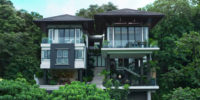Fumihiko Maki’s Aga Khan Museum is a simple rectangular volume. It shares a 17-acre site in Toronto with the newly opened Ismaili Centre designed by Charles Correa (not shown).
Toronto’s cultural brand has moved into a new galaxy. After four years of construction, the Aga Khan Museum, designed by Pritzker Prize–winner Fumihiko Maki, opened east of the city’s downtown on Thursday.
With the new, sublimely detailed 124,000-square-foot building, Tokyo-based Maki and Associates (with Toronto’s Moriyama & Teshima Architects) expand the city’s repertoire of museums and university buildings designed by local and international architects, including Frank Gehry, Norman Foster, Will Alsop, and Daniel Libeskind. The museum—a restrained canted box clad in a super-white Brazilian granite, with an interior courtyard open to the sky and flooded with daylight—is part of a graceful 17-acre compound. It is bookended to the west by the stunning, newly opened Ismaili Centre by legendary Mumbai architect Charles Correa. Standing below the faceted glass dome in his center’s prayer hall, Correa, 84, presented a series of spontaneous meditations on architecture at a press event earlier in the month, celebrating the opening of the museum and the center: “There is God’s sky above and God’s earth below, and when you acknowledge both of them, that moves you.”
The press event recognized architectural luminaries and served as an acknowledgment that most North Americans know very little about Muslim contributions to the arts. “Here is a simple but devastating question,” challenged Aga Khan Museum director Henry Kim: “How many Muslim artists from the past can you name?”
To help fill in the knowledge gap, Maki’s museum doubles as a cultural center, offering live dance and music performances within the glass-walled interior courtyard and in an intimate teak-lined theater. The packed outreach schedule includes curator talks, poetry readings, and foodie events that promise to shift or, at least, rebalance the public perception of war-torn areas such as Afghanistan and Iran. Educating the public about the depth and humanity of Islamic art was always the fundamental idea behind the museum complex, as conceived more than a decade ago by the Aga Khan, the wealthy philanthropist, urban thinker, and spiritual leader of the Ismaili people around the world. To that end, the Aga Khan gifted his extraordinary art collection. Assembled over many generations by his family, this includes more than 1,000 objects spanning 10 centuries.
Hexagonal skylights cast delicately patterned shadows into the permanent gallery on the museum’s ground floor and temporary galleries on the second, where visitors are given plenty of room to inspect treasures such as the 11th-century Canon of Medicine, several pages of the 16th-century Shahnameh—considered to be one of the greatest painted manuscripts of all time—and a perfectly preserved 13th-century silk robe once worn by a Mongol nobleman. Ceramics, metalwork, and books are placed within seamless, high-security glass casework, designed by Studio Adrien Gardère of Paris. There are architectural replicas and cultural lodestones, including a reconstruction of a Mumluk fountain, which once refreshed the historic palaces of Cairo. The Bellerive Room, another reconstruction, offers a fascinating peek at the interior of the Geneva residence owned by the Aga Khan’s aunt and late uncle, the Princess Catherine and Prince Sadruddin Aga Khan. The family’s ceramic collection is also on display.
The museum complex exemplifies the big thinking and attention to detail that has long defined the Aga Khan Awards for Architecture and the Aga Khan Trust for Culture, an agency of the Aga Khan Development Network. Using a discreet motif, Maki’s team elaborated on several geometric mashrabiya patterns cut into some of the teak walls in the auditorium. This pattern, inspired by the Islamic Jali screen, is also printed on the courtyard’s 43-foot-tall walls of double-pane-insulated glass, casting beautiful shadows on the interior walls, ceiling, and heated stone floor.
The master plan was inspired by the vast urban dimensions of the plaza in Istanbul that links the Blue Mosque to the Hagia Sofia, said Gary Kamemoto, a director at Maki and Associates, during the museum’s opening. To powerful effect, the civic plaza features five minimalist black reflecting pools offset by lush plantings of mature trees. Designed by the Beirut landscape architect Vladimir Djurovic, the plaza provides a serene urban refuge and an effective acoustical buffer from the noisy Don Valley Parkway running along the edge of the sloped site.
Toronto is North America’s fourth-largest city, widely recognized as a place that sits comfortably with cultural diversity. The majority of its population was born outside of Canada, and some 150 languages are spoken within the metropolis. With that in mind, and reportedly as a thank you to Canada for welcoming Ismailis when they faced persecution in Uganda during the 1970s, the wealthy Aga Khan—renowned for founding universities and hospitals in the Muslim world as well as for his patronage of Islamic studies at Harvard University and the Massachusetts Institute of Technology—gave the $300-million museum and civic complex to Toronto. It is the first art museum that the Aga Khan Trust for Culture has built to date.










Post a comment to this article
Report Abusive Comment